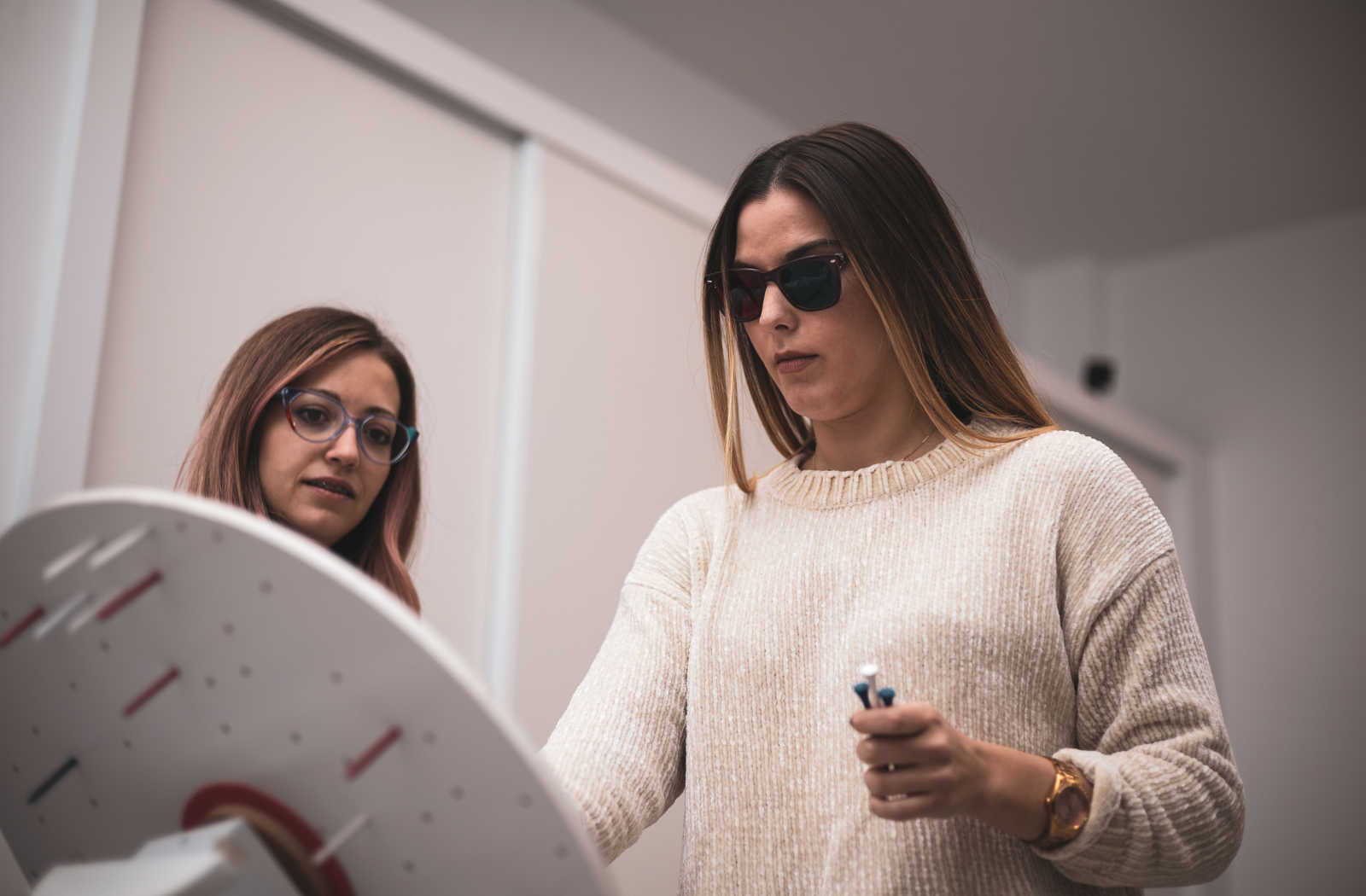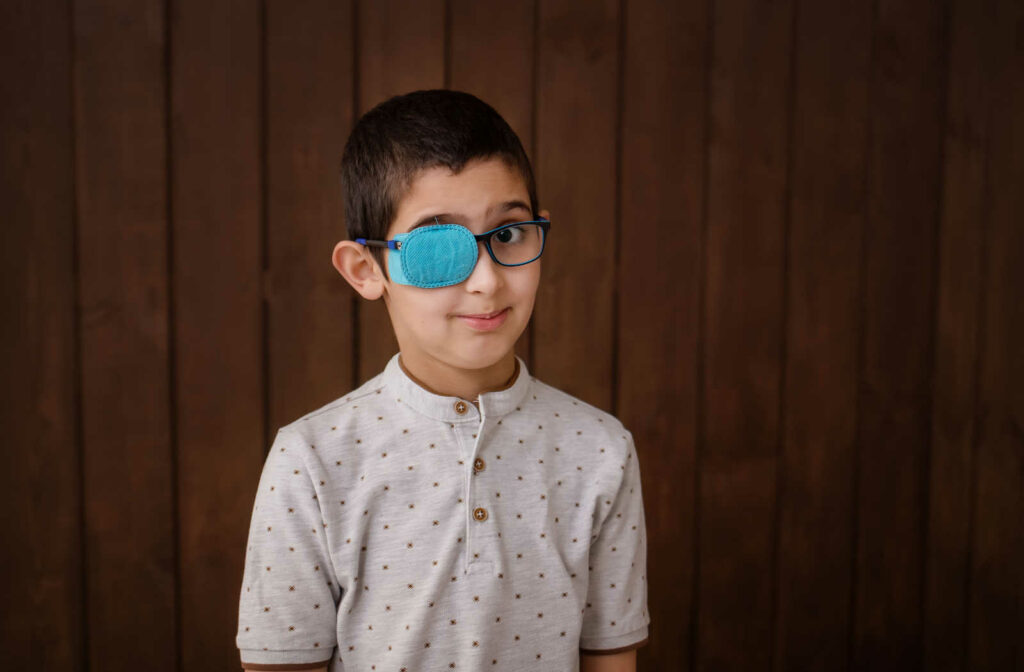A lazy eye, also known as amblyopia, is a common vision disorder that occurs when the brain and the affected eye do not work together correctly, leading to reduced vision in one eye. A lazy eye might be able to be corrected with vision therapy, using evidence-backed techniques to address errors in visual skills.
An optometrist can diagnose a lazy eye in children, usually after an eye exam. However, adults can also have a lazy eye. This may be because they never received treatment or had their lazy eye return after previous treatment.
There are many techniques a doctor may use to correct a lazy eye, including patching, which is the process of wearing an eye patch while doing eye exercises. While some studies have indicated patching might help correct a lazy eye in children, it hasn’t been proven effective in adults.
What is a Lazy Eye?
A lazy eye occurs when the brain and the affected eye do not work together correctly, leading to reduced vision in one eye. A lazy eye typically develops in early childhood when the brain is still developing but can continue into adulthood if left untreated.
One of the most common causes of lazy eye is strabismus, also known as crossed eyes, which is a misalignment of the eyes where one eye turns inward, outward, upward or downward. Other causes of lazy eye include unequal prescriptions between the two eyes, where one eye has significantly more or less refractive error than the other.
In either case, the brain receives different images from each eye and attempts to compensate. The brain suppresses the image from the misaligned eye in response, resulting in a weaker connection between that eye and the brain.
Your stronger eye can typically take over visual tasks, so many people may not notice any symptoms from a lazy eye unless they also have a turned eye. However, if a lazy eye goes untreated, it may eventually lead to total vision loss in that eye. This vision loss can affect your peripheral vision and depth perception, and make it harder to complete tasks that require both eyes.
Early diagnosis and treatment might be able to improve vision in the affected eye and prevent permanent vision loss. This is where vision therapy comes in.

What is Vision Therapy?
Vision therapy is a program for the eyes and brain designed to improve vision skills and correct vision problems. It can be an intricate process of training and learning that goes beyond simply “eye exercises.” Vision therapy involves a series of activities and therapies tailored to your specific vision problems and needs.
An eye doctor can use vision therapy to treat a wide range of vision problems, including:
- A lazy eye (Amblyopia)
- Crossed eyes (Strabismus)
- Convergence insufficiency
- Binocular vision problems
You can also use vision therapy to improve visual skills, such as eye tracking, focusing, and depth perception.
Vision therapy aims to improve the brain’s ability to use your eyes, training them to work together toward better visual function and quality of life. Vision therapy is not a quick fix and requires dedication and effort to see results. However, for many people with vision problems, vision therapy could be a highly effective treatment option.
Is Patching Effective for Adults?
Eye patching is a common treatment option for a lazy eye in children. The idea behind patching is simple: improve the vision in the lazy eye by forcing it to become more active and sending more visual information to the brain. However, some experts find this technique outdated, putting undue stress on a child, and prefer treatments that involve both eyes.
Research has shown that patching is generally more effective in children than adults. This change in effectiveness may be because the brain is more adaptable in children and can better make connections between the affected eye and the brain.
However, this doesn’t mean adults have nothing to gain from vision therapy. Vision therapy isn’t a single treatment. Instead, it’s a collection of exercises and activities designed to address your unique needs. Your eye doctor may decide patching could be a small part of your vision therapy program.
Vision Therapy for Adults
Once, adults with amblyopia were told they’d “just have to live with it.” However, researchers have made great strides in discovering methods to address a lazy eye in adults.
Vision therapy in adults focuses on improving visual processing skills by training the brain’s ability to use the eyes together.
Here are some common types of vision therapy methods for a lazy eye:
- Perceptual learning: Perceptual learning involves repeating visual tasks to improve visual processing skills. These tasks may include identifying letters, shapes, and colours or tracking moving objects. At least one study has shown perceptual learning can help adults with amblyopia improve their ability to use both eyes together.
- Convergence exercises: When someone is dealing with convergence insufficiency, a specialist might give them exercises to improve how their eyes work together. Activities may include exercises to improve eye teaming and coordination, such as practicing focusing on objects or using prisms.
- Virtual reality: Early studies have shown using video games in a virtual reality headset may help adults develop their binocular vision. Programs like Optics Trainer immerse patients in gameplay designed to improve visual processing skills, eye teaming, and hand-eye coordination.
Vision Therapy Designed for You
Effective vision therapy is tailored to your specific needs and goals. The type of therapy recommended will depend on your vision problems and the severity of your lazy eye. Avenue Optometry & Vision Therapy specializes in high-tech solutions to help you get the most out of your eyesight.
If you have a lazy eye and you’ve been told there’s nothing to do, book an appointment for an eye exam today, and our expert team will be happy to walk you through your options.




